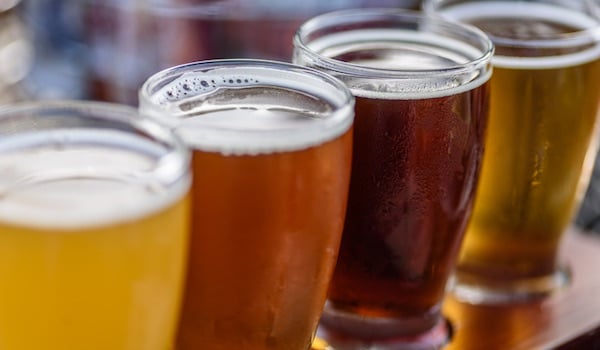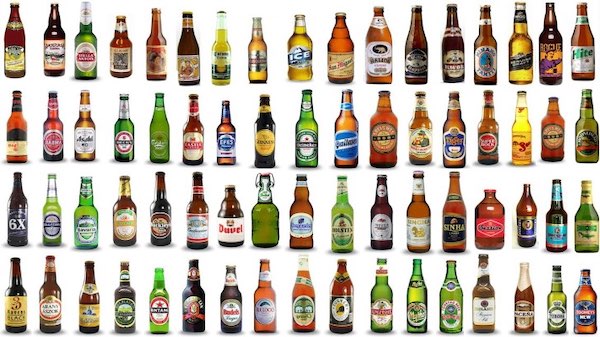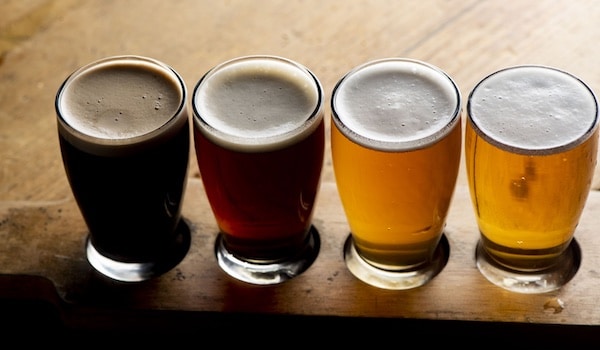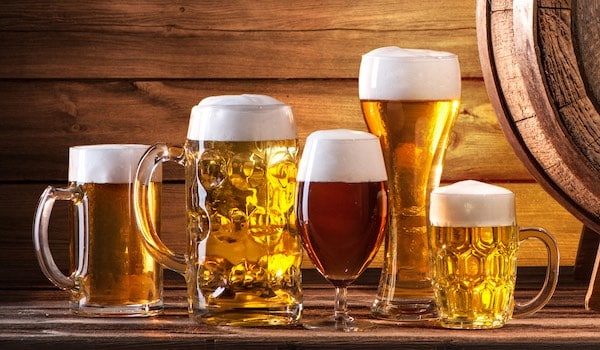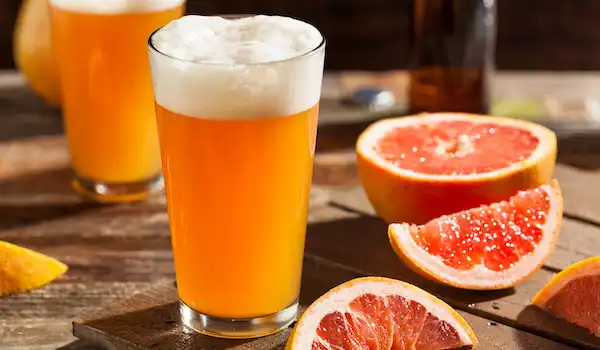
In This Article
- Introduction to Fruit Beer
- What Is Fruit Beer?
- When and How Is Fruit Added
- Is Fruit Beer Sweet
- Popular Fruit Beer Styles
- Can Fruit Beer Be Aged?
- Best Foods to Pair with Fruit Beer
- Top Fruit Beers to Try
- Conclusion
Introduction to Fruit Beer
People have been combining fruit and beer for centuries, which goes beyond merely tossing a lime wedge into a Corona. It’s a fascinating part of the brewing process, with distinctive qualities of the hops and malt playing with sweet or sour fruit additions to create a magical final product.
Brewers have been experimenting with fruit additions in basically every style of beer. There are also a lot of variables that go into brewing a fruit beer, like how the fruit is introduced or the state it’s in. Between food pairing and even aging beers in a cellar, there are a ton of ways drinkers can experiment as well.
Here’s everything you need to know about fruit beer.
What Is Fruit Beer?
A fruit beer is any beer style that has an added fruit product. It’s not an official beer style like a Pilsner or IPA, but more of a category. You can differentiate fruit beers by how the fruit is added.
Some brewers add fresh fruit for natural and unprocessed flavor, though this requires sanitizing and care to avoid contamination. Fruit purée is more commonly used — it’s easier to measure, mix, and ferment since it’s free from seeds or pulp. Juice is another convenient way to add fruit, though brewers must be careful it doesn’t thin out the beer too much. Even the zest or peel of fruits can add bright, aromatic flavors, particularly in styles like Belgian wits, India pale ales, saisons, and some lagers. Some brewers use natural or artificial extracts, which offer a consistent flavor, long shelf life, and are easy to add after fermentation.
When and How Is Fruit Added
Just like hops, the timing of fruit additions affects the final flavor and aroma.
Adding fruit during the boil is common in traditional styles and can yield subtle sweet or tart flavors. However, boiling sterilizes the fruit and may dull aromatics. Adding fruit during primary fermentation allows fruit sugars to ferment along with the malts, which reduces sweetness but adds complexity — this method is often used in sour ales. Fruit added during secondary fermentation preserves more of the fruit’s natural character without impacting ABV, making it ideal for aromatic beers like sours, saisons, and wheat beers.
Is Fruit Beer Sweet
Not all fruit beers are sweet. Many styles are actually tart or sour, and the sweetness depends largely on the type of fruit used and how it’s added.
Sweet fruit beers often involve malt-forward styles like porters or stouts with fruits such as cherry, peach, or currants. These beers can taste rich and dessert-like due to residual sugars from the fruit. On the other hand, sour beers — like Berliner Weisse with raspberries — create a puckering experience. Belgian fruit beers and lambics frequently have a tart profile, while lagers or pale ales may use fruit to subtly enhance aroma and flavor without dominating the beer.
Popular Fruit Beer Styles
Edible fruit can be used to enhance almost any beer style, so there’s a whole world of possibilities for brewers to explore.
- Wheat Beers: Citrus fruits like orange and lemon, along with peach, are used to complement the soft flavors of wheat beers like Belgian Witbier, Hefeweizen, and Wheat Ales.
- IPAs: Citrus-forward IPAs can really benefit from mango, grapefruit, passionfruit, or even pineapples to work alongside the hop profile of the beer, yet showcase the flavors of the fruit.
- Sours & Lambics: Classic Belgian styles like Kriek (cherry), Framboise (raspberry), and Golden Ales (lemon zest) will have tart, funky, or complex flavor profiles.
- Stouts & Porters: Robust flavors from cherry, plum, blackberry, and currants add richness to contrast with the roasted malts. These beers are perfect for a post-dinner treat or campfire hang.
- Lagers and Pilsners: For patio season, brewers add lime, strawberry, and watermelon to crisp and clean lagers. The subtle fruit notes won’t overpower other flavors or get in the way of drinkability.
Can Fruit Beer Be Aged?
For dedicated beer aficionados, aging beer is an endlessly fascinating (and sometimes frustrating) pursuit. Some fruit beers can be aged, but you’ll want to ensure you’re trying it with the right beer.
Beers best suited for aging include high-ABV fruit beers (imperial stouts or porters with 10% ABV or more), barrel-aged sours, Belgian-style lambics, saisons with fruit, and wild ales.
A few tips for aging:
- Check beer forums or ask the brewery whether aging is recommended.
- Store bottles upright in a cool, dark place with low humidity.
- Buy multiple bottles to enjoy over time and compare the flavor evolution.
Best Foods to Pair with Fruit Beer
Pairing fruit beer with food can enhance the experience — here are some great ideas:
- Tart or Sour Fruit Beers: Delicate beers like Belgian saisons or sours will pair well with salads, grilled fish, herbed chicken, and goat cheese. Pairing beers that incorporate the same fruits as salad vinaigrette is your best bet!
- Sweet or Rich Fruit Beers: This is where you want to base your pairing on the specific fruit used. Chocolate desserts and cheesecake often go hand in hand with raspberry, so a sweeter Belgian ale, or even a stout with blackberries, will provide a post-dinner indulgence. Pancakes or waffles for brunch would pair well with a cherry porter (or even a mimosa-themed beer).
- Tropical or Bold Fruit IPAs: This type of beer has enough flavor to stand up to spicy tacos, BBQ ribs, and Thai or Indian cuisine.
Top Fruit Beers to Try
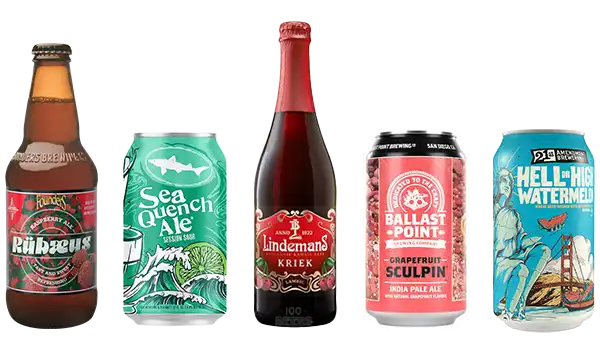
- Founders Rubaeus: (5.7% ABV) – This raspberry ale from the Grand Rapids OG boasts a rich berry aroma and refreshing tartness. It’s one of the best American beers to emulate a Belgian-style fruit beer.
- Dogfish Head SeaQuench Ale: (4.9% ABV) – There’s nothing better for summer than this lime-infused sour with salty and citrus notes. You can always count on this Delaware brewery to deliver when it comes to artisanal and culinary beers.
- Lindemans Kriek: (3.5% ABV) – Traditional Belgian cherry Lambics are the original fruit beer, and this classic is surprisingly drinkable considering its deep red color and elegant complexity.
- Ballast Point Grapefruit Sculpin: – (7% IPA) There are already some grapefruit aromas in the classic West Coast IPA. However, the San Diego brewery added this citrusy addition to amp up the flavor.
- 21st Amendment Hell or High Watermelon: (4.9% ABV) – This is absolutely one of the most refreshing beers you’ll find anywhere. With 17 IBUs and unmistakable watermelon flavors, you know what you’ll need for patio season.
Conclusion
Fruit flavors are deeply connected to beer, even in styles that don’t explicitly include fruit. Whether you’re brewing or sipping a fruited sour, a crisp lager with citrus, or a dark stout enhanced with berries, fruit beer offers a creative, flavorful experience that spans styles, seasons, and palates.
Drink curiously — and responsibly.


